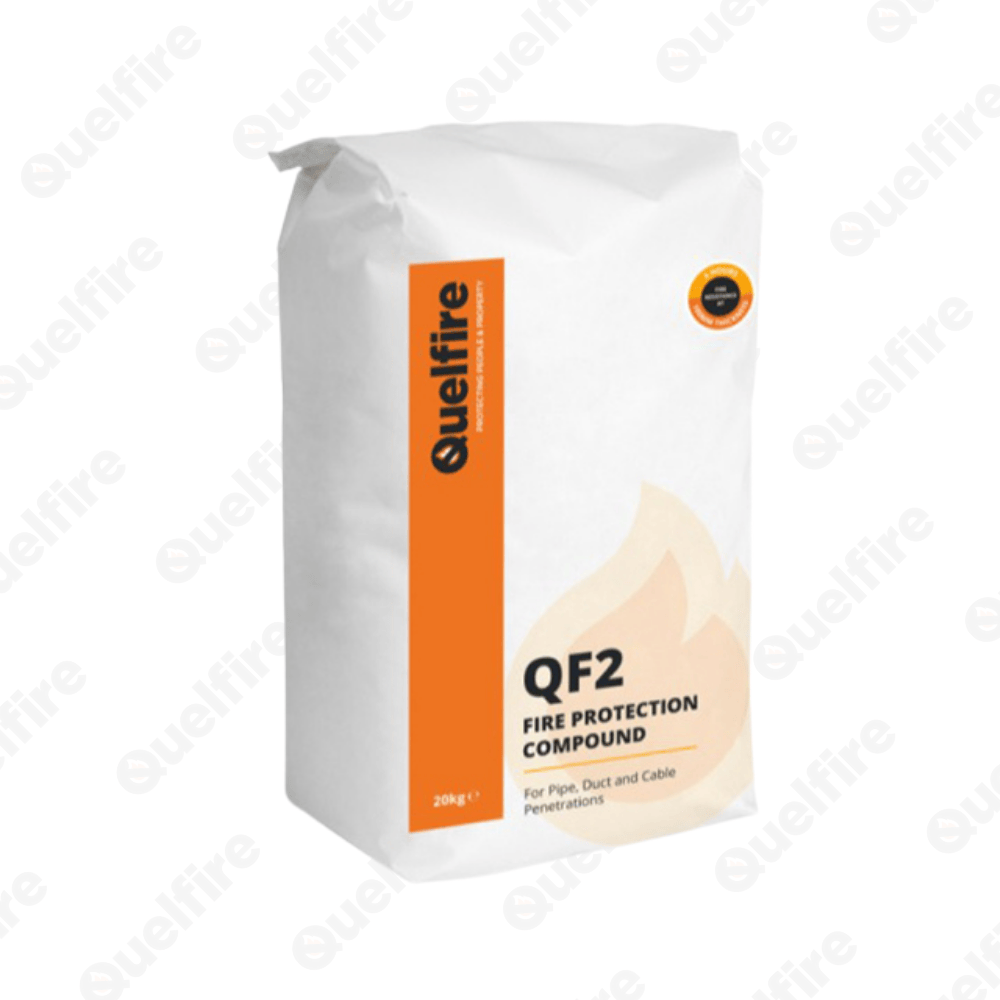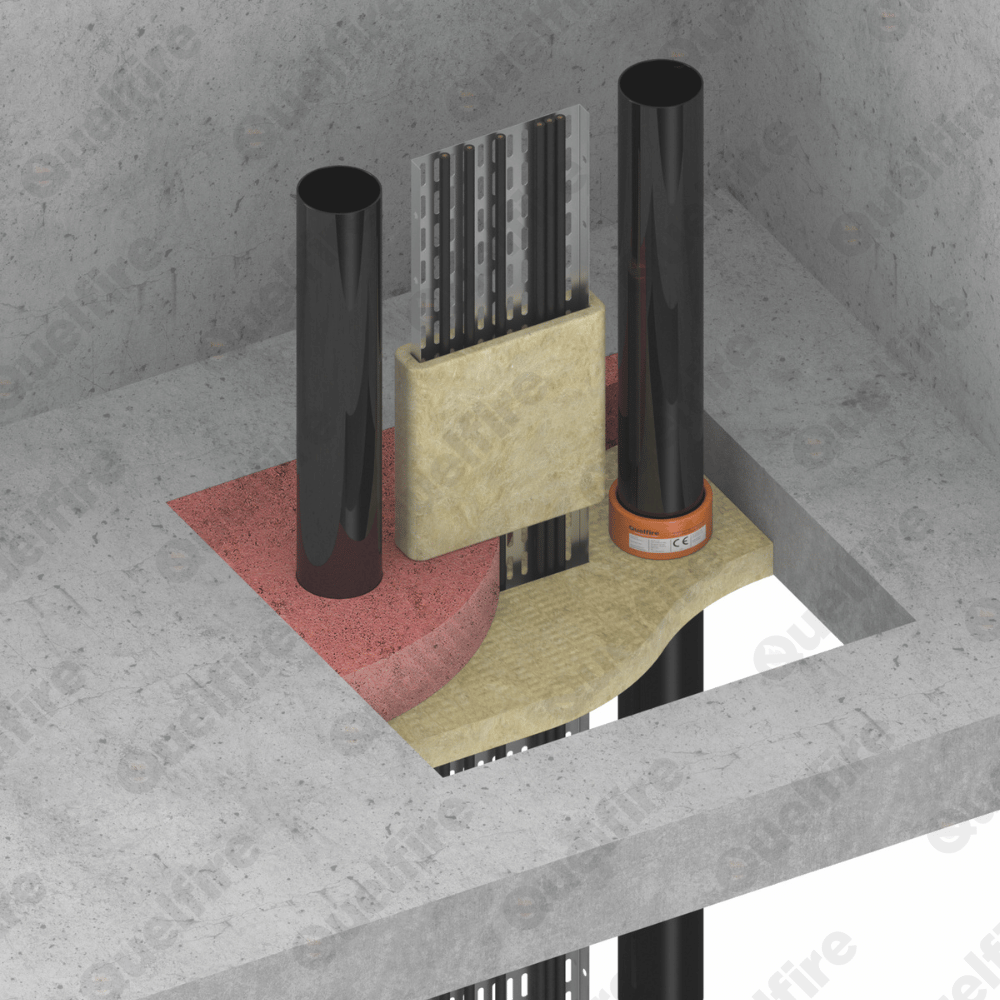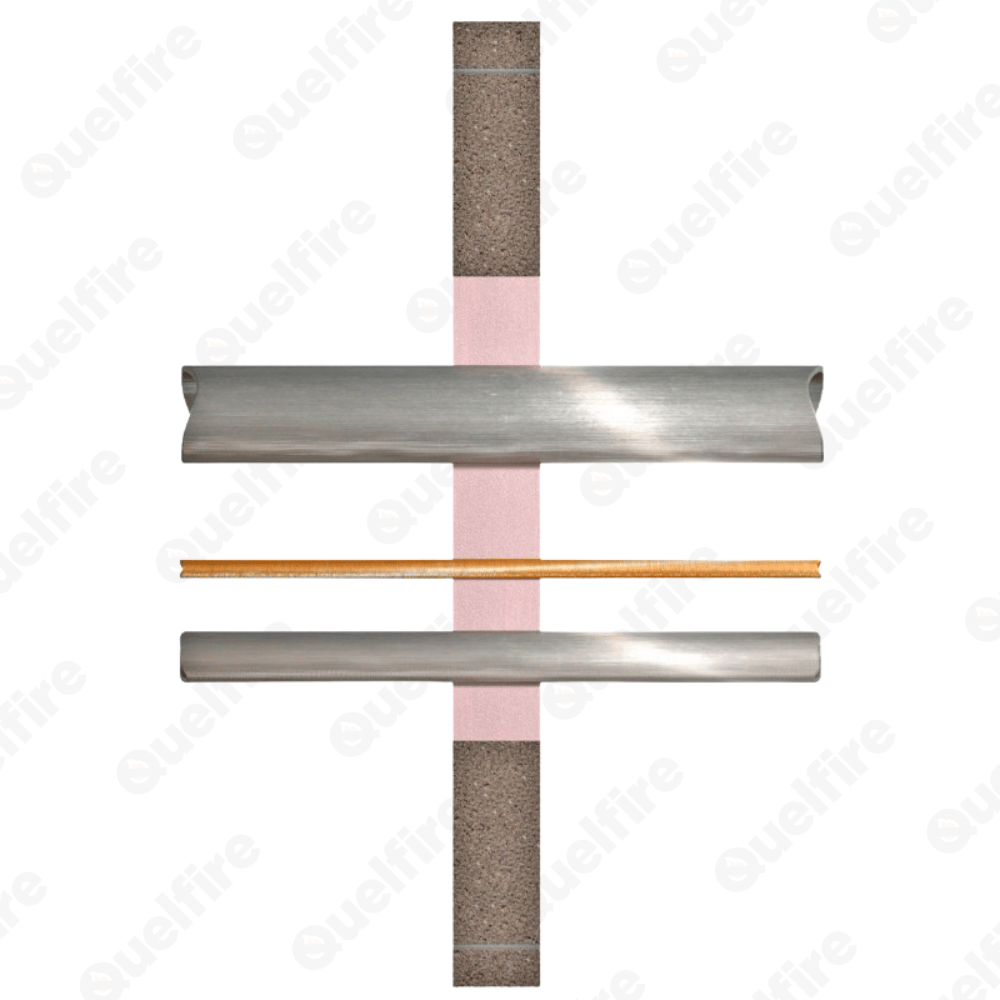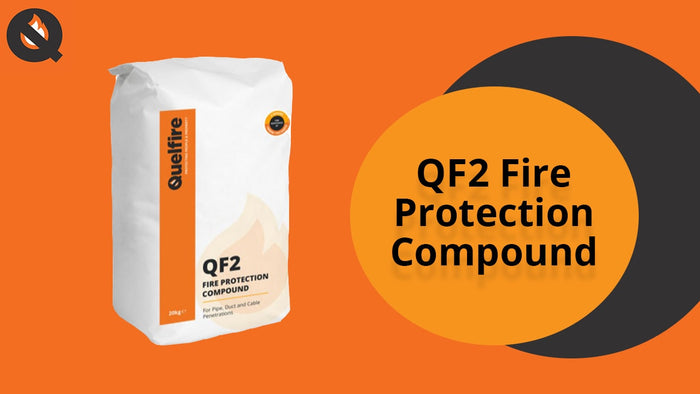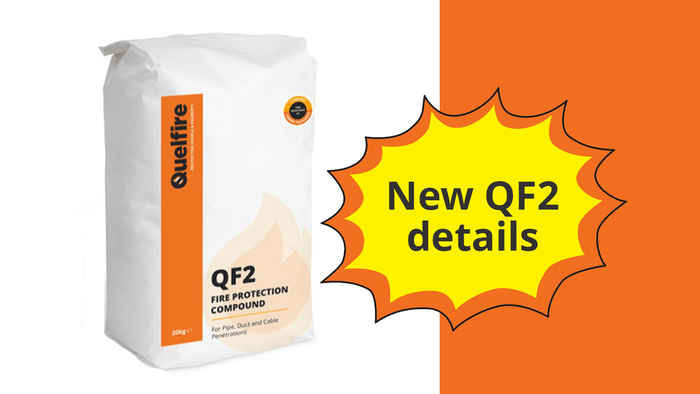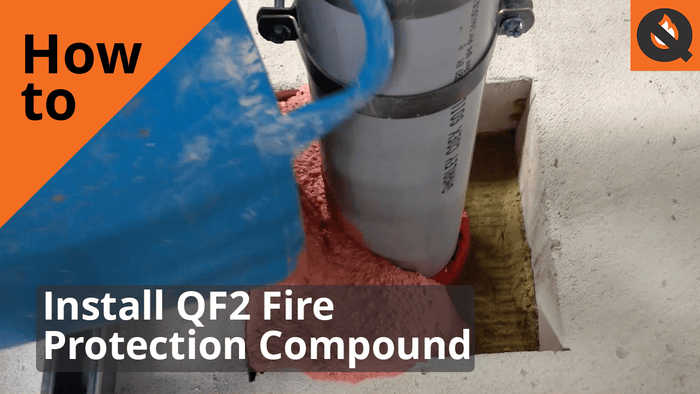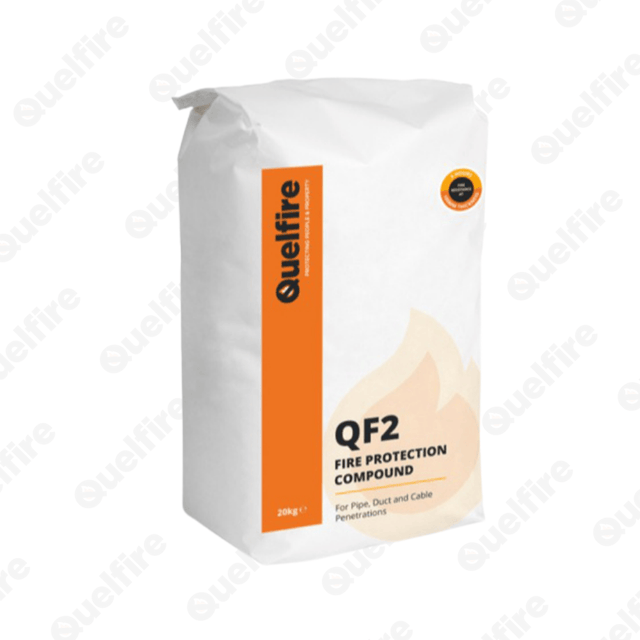Fire Protection Compound | QF2
Description
Description
QF2 Fire Protection Compound is designed to fill gaps where cables and pipework pass through fire compartment walls and floors. It can be used to firestop various applications, such as mechanical and electrical service penetrations, requiring little shuttering.
As the compound cures, it expands slightly by 0.1% to form a load-bearing, fire-rated seal. Like other firestopping products, it helps maintain a building’s compartmentation by containing the fire to its area of origin for as long as it has been tested.
QF2 can be used alongside other firestopping products, such as QWW & QuelCoil Intuwraps and QWR Fire Collars. It is also ideal for service risers.
Standards & Approvals
Standards & Approvals
The QF2 Fire Protection Compound is suitable for rigid walls and floors. It should be mixed with water in a bucket or concrete mixer, achieving consistencies that range from pourable to a stiffer mix so it can be troweled into place.
QF2 can be used in conjunction with other QuelStop System products, such as the QWW Intuwrap, QuelCoil Intuwrap, and QWR Fire Collar.
The QF2 Fire Protection Compound will expand slightly upon curing (0.1%), forming a rigid and load-bearing seal at 100mm thick.
The setting time of this product depends on the temperature. It can be built up further within two to three hours if larger barriers are needed.
Vertical openings through floors:
It is recommended that appropriate shuttering such as MW Mineral Wool Slabs should be cut to suit the penetration slightly oversize and around all penetrating services so when installed it will be a good friction fit.
The MW Slab should be positioned towards the bottom of the hole to allow the correct depth of the QF2 Fire Protection Compound to be installed on top – normally a minimum of 100mm but this should be checked in accordance with the test evidence and recommendations.
Consideration should be given to any necessary temporary or permanent support that may also be required.
Once the MW Shuttering Slab is securely fitted, any necessary closure devices required around the service penetrations such as QWW Intuwraps to plastic pipes may be installed.
The QF2 Fire Protection Compound can then be poured on top of the MW Shuttering Slab.
Once the QF2 Fire Protection Compound has cured, the shuttering can be removed so that the fire seal is visible. If retained, we recommend that the shuttering is at least cut back around the service so that the fire seal is visible and exposed to fire. All combustible materials such as plywood, must be removed, after the QF2 Fire Protection Compound has set.
Where the barrier is required to provide a load bearing capability, consideration should be given to structural support, such as reinforcing bars. Consideration may also be given to the use of a permanent shuttering system. In all loadbearing situations the QF2 Fire Protection compound thickness must be at least 100mm.
As the load bearing performance particularly in un-reinforced situations is dependent on compressive membrane action against the concrete slab edge or other rigid boundary, it is essential to check that this is vertical, before commencing installation.
Where the thickness of the seal is built up using multi layers, the structural strength of the seal may be reduced. It is therefore recommended, particularly in load bearing situations, that a maximum of 10% thickness is installed initially, and the remaining thickness applied as a further single operation.
Building up the seal in several operations with the individual layers being allowed to set, will result in a weak laminated structure with severely reduced load bearing performance.
Cutting out part of the finished seal to accommodate additional services, must not be undertaken without review by a competent person, of the effect on the structural integrity of the seal and also to ensure that the seal will still fall within the tested scope of application.
Horizontal Openings through walls:
It is recommended that the QF2 Fire Compound should be installed to a minimum thickness of 100mm. The QF2 Fire Protection Compound may be pre-cast into convenient sized blocks with a stiff mix being used as a bedding mortar or the QF2 Fire Protection Compound can be plastered onto a MW shuttering slab to the required depth.
QF2 Fire Protection Compound is not waterproof and as it is mostly gypsum based will absorb water if exposed.
It can potentially be treated with a 2-part epoxy paint in order to offer some waterproofing but it must be fully dried before application and we recommend a trial is carried out before application to check compatibility and adhesion.
*Please note that custom made items can expect to have longer lead times. Next working day is typical but can depend on outside factors not controlled by Quelfire.
Product Info & Features
Product Information
| Property | Details |
|---|---|
| Physical Properties | |
| Colour | Pink |
| Density loose bulk (kg/m³) | 650 |
| Density wet cast (kg/m³) | 1300 – 1400 |
| Density over dry (kg/m³) | 850 – 950 |
| Setting time (mins) | 60 |
| Expansion on setting (%) | 0.1 |
Features & Benefits
-
 Fire Tested to BS EN1366-3
Fire Tested to BS EN1366-3
-
 Up to 4 hour fire rating
Up to 4 hour fire rating
-
 Suitable for load bearing situations
Suitable for load bearing situations
-
 Expands slightly on curing to form a rigid seal
Expands slightly on curing to form a rigid seal
-
 The use of extensive shuttering is not necessary
The use of extensive shuttering is not necessary
-
 Can be used in conjunction with other Quelfire Products such as the QWW & QuelCoil Intuwraps and QWR Fire Collars
Can be used in conjunction with other Quelfire Products such as the QWW & QuelCoil Intuwraps and QWR Fire Collars
-
 Ideal for service risers
Ideal for service risers
-
 Suitable for use in concrete floors, hollow core slabs and steel profiled deck floor systems
Suitable for use in concrete floors, hollow core slabs and steel profiled deck floor systems
Product Information
| Property | Details |
|---|---|
| Physical Properties | |
| Colour | Pink |
| Density loose bulk (kg/m³) | 650 |
| Density wet cast (kg/m³) | 1300 – 1400 |
| Density over dry (kg/m³) | 850 – 950 |
| Setting time (mins) | 60 |
| Expansion on setting (%) | 0.1 |
Features & Benefits
-
 Fire Tested to BS EN1366-3
Fire Tested to BS EN1366-3
-
 Up to 4 hour fire rating
Up to 4 hour fire rating
-
 Suitable for load bearing situations
Suitable for load bearing situations
-
 Expands slightly on curing to form a rigid seal
Expands slightly on curing to form a rigid seal
-
 The use of extensive shuttering is not necessary
The use of extensive shuttering is not necessary
-
 Can be used in conjunction with other Quelfire Products such as the QWW & QuelCoil Intuwraps and QWR Fire Collars
Can be used in conjunction with other Quelfire Products such as the QWW & QuelCoil Intuwraps and QWR Fire Collars
-
 Ideal for service risers
Ideal for service risers
-
 Suitable for use in concrete floors, hollow core slabs and steel profiled deck floor systems
Suitable for use in concrete floors, hollow core slabs and steel profiled deck floor systems
Standard Installation Detail Examples
| File | |
|---|---|
| QF2-CF150-00a | Blank Seal for Rigid Floor | View |
| QF2-CF150-00b | First Fix Formwork Deck Box Blank Seal | View |
| QF2-CF150-02 | Cable Penetrating a Rigid Floor | View |
| QF2-HC150-14 | Conduit with Cables Penetrating a Hollow Core Floor | View |
| QF2-HC150-12 | Sleeved Gas Pipe Penetrating a Hollow Core Floor | View |
Browse More Tested Details
We have listed just five examples of tested details using the putty pad, though there are more available. In total, our standard installation details library contains over 600 tested details across our full product range.
Specification Details
| Category | Property | Value |
|---|---|---|
| Physical Properties | Colour | Pink |
| Density loose bulk (kg/m³) | 650 | |
| Density wet cast (kg/m³) | 1300 – 1400 | |
| Density over dry (kg/m³) | 850 – 950 | |
| Setting time (mins) | 60 | |
| Expansion on setting (%) | 0.1 | |
| Acoustic Insulation Performance | Mortar at 100mm thickness | QF2 Fire Protection Compound |
| R’w (C; Ctr) (dB) | 47 (1) | |
| Structural Properties | Consistency | Compressive Strength (N/mm²) |
| Pourable | 24 hours: 2.5, 28 days: 5 | |
| Plastic | 24 hours: 4, 28 days: 8 | |
| Stiff | 24 hours: 5, 28 days: 10 | |
| Thermal Conductivity & U Values | Material | QF2 Fire Protection Compound |
| Thermal Conductivity ‘K’ (w/m°C) | 0.21 | |
| Thickness (mm) | 100 | |
| Thermal Resistance ‘R’ (t/k) | 0.48 | |
| U Value I / ‘R’ | 2.1 | |
| Yield | Required material | One square metre at 100mm thickness requires approx. 4 x 20kg sacks of QF2 Fire Protection Compound. |
| Packaging & Storage | Storage | QF2 is supplied in 20kg bags which must be stored in dry conditions. Shelf life, in an unopened bag, is typically 12 months. |
| Health & Safety | Protective measures | QF2 Fire Protection Compound contains gypsum plaster and natural, or heat-processed aggregates. Protective clothing, including gloves, a dust mask, and safety glasses, should be worn during mixing. |
| Material Safety Data Sheet | Available on request. | |
| Mixing | Mixing process | QF2 is mixed on-site with clean water in a plastic container, slowly adding the dry powder while stirring by hand or power mixer. |
| Recommended mixes (Dry Powder / Water Ratio) - By Volume | Pourable / Floors: 2 1/2 : 1 Stiff / Walls: 3 : 1 |
|
| Recommended mixes (Dry Powder / Water Ratio) - By Weight | Pourable / Floors: 1.3 : 1 Stiff / Walls: 1.9 : 1 |
|
| Usability time | The wet mix remains usable for approximately 45-60 minutes depending on batch size, water content, and temperature. | |
| Waterproofing | Water resistance | QF2 Fire Protection Compound is not waterproof. It can be treated with a 2-part epoxy paint for waterproofing, but it must be fully dried before application. |
| Category | Property | Value |
|---|---|---|
| Physical Properties | Colour | Pink |
| Density loose bulk (kg/m³) | 650 | |
| Density wet cast (kg/m³) | 1300 – 1400 | |
| Density over dry (kg/m³) | 850 – 950 | |
| Setting time (mins) | 60 | |
| Expansion on setting (%) | 0.1 | |
| Acoustic Insulation Performance | Mortar at 100mm thickness | QF2 Fire Protection Compound |
| R’w (C; Ctr) (dB) | 47 (1) | |
| Structural Properties | Consistency | Compressive Strength (N/mm²) |
| Pourable | 24 hours: 2.5, 28 days: 5 | |
| Plastic | 24 hours: 4, 28 days: 8 | |
| Stiff | 24 hours: 5, 28 days: 10 | |
| Thermal Conductivity & U Values | Material | QF2 Fire Protection Compound |
| Thermal Conductivity ‘K’ (w/m°C) | 0.21 | |
| Thickness (mm) | 100 | |
| Thermal Resistance ‘R’ (t/k) | 0.48 | |
| U Value I / ‘R’ | 2.1 | |
| Yield | Required material | One square metre at 100mm thickness requires approx. 4 x 20kg sacks of QF2 Fire Protection Compound. |
| Packaging & Storage | Storage | QF2 is supplied in 20kg bags which must be stored in dry conditions. Shelf life, in an unopened bag, is typically 12 months. |
| Health & Safety | Protective measures | QF2 Fire Protection Compound contains gypsum plaster and natural, or heat-processed aggregates. Protective clothing, including gloves, a dust mask, and safety glasses, should be worn during mixing. |
| Material Safety Data Sheet | Available on request. | |
| Mixing | Mixing process | QF2 is mixed on-site with clean water in a plastic container, slowly adding the dry powder while stirring by hand or power mixer. |
| Recommended mixes (Dry Powder / Water Ratio) - By Volume | Pourable / Floors: 2 1/2 : 1 Stiff / Walls: 3 : 1 |
|
| Recommended mixes (Dry Powder / Water Ratio) - By Weight | Pourable / Floors: 1.3 : 1 Stiff / Walls: 1.9 : 1 |
|
| Usability time | The wet mix remains usable for approximately 45-60 minutes depending on batch size, water content, and temperature. | |
| Waterproofing | Water resistance | QF2 Fire Protection Compound is not waterproof. It can be treated with a 2-part epoxy paint for waterproofing, but it must be fully dried before application. |
Videos
Frequently Asked Questions About QF2
What is a fire compound?
What is a fire compound?
Fire protection compound is a product designed to prevent the spread of fire and smoke by maintaining a building’s compartmentation.
It is manufactured from lightweight, fire-resisting aggregates in organic binders and high-quality gypsum cements.
What thickness should QF2 be applied at?
What thickness should QF2 be applied at?
Usually a minimum of 100mm, but this should always be confirmed against the product’s test evidence and specific application.
Is there fireproof concrete?
Is there fireproof concrete?
Concrete cannot be used as a substitute for fire protection compound. Where compound slightly expands upon curing, concrete shrinks and therefore, may not perform the same in the event of a fire.

